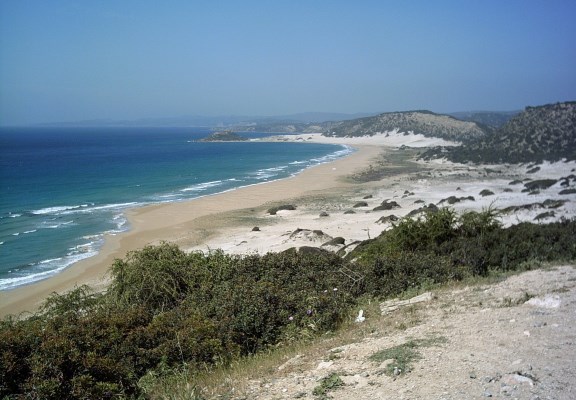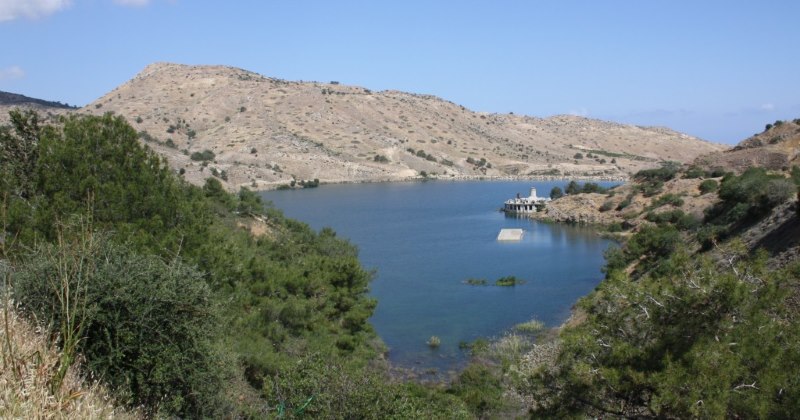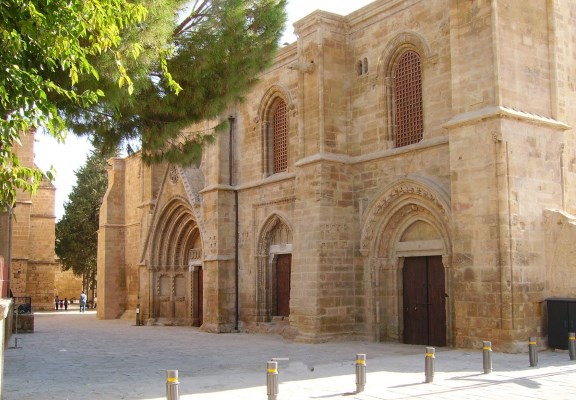North Cyprus – Destination Karpaz!

North Cyprus – Destination Kyrenia!
3 March, 2010
North Cyprus – Destination Famagusta!
31 March, 2010No holiday to North Cyprus can be complete without a visit to the Karpaz Peninsula, this is the Cyprus of old, a land almost unspoilt by the savage hand of modern development, where Mother Nature still holds the reins of power; where donkeys, trees, flowers, and cereal crops dot the landscape as far as the eye can see, before tapering off into the blue waters of the Mediterranean.
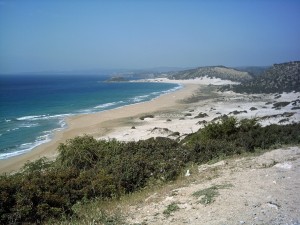
Golden Beach – Karpaz
There is also an abundance of history with ancient city sites, Byzantine period basilicas with intricate mosaics; conglomerations of timeworn churches; rural traditional Cypriot villages whose inhabitants pursue a way of life now as they have done for the past few hundred years. Here in an agricultural scene the story of Cyprus over the millennia unfolds.
It is possible to “do” the Karpaz in a day but I don’t recommend it. A few days are needed to see this part of Cyprus where time almost stands still. To rush through this peaceful, quiet land means to miss so much. From the moment Bogaz on the south coast is left behind there are so many places to see. The Eco village of Buyukkonuk is a short drive off the main road, Kantara Castle beckons from high on the mountain top, Bafra beach with its white sand is a good swimming stop and becoming one of the most popular beaches in the area.
From the village of Ziyamet turn right for the church of Panayia Kanakaria. Partly restored monastic buildings flank one side of the walled courtyard and over the south doorway there is a fresco of the Virgin Mary. The church does not have regular opening hours but if it is open, there are visible remains of the mosaic picture that once graced the central apse.
Returning to the main road and continuing on into the peninsula, the next village is Yesilkoy (Green village) where a vast amount of citrus, pomegranates, potatoes, and kolokas (a root vegetable similar to a sweet potato) are grown. In the centre of the village there is a restaurant on stilts and beside it a strange tree that is called The Osage Orange. Botanically the name is Maclura pomifera, it is a member of the Mulberry family, and the large, inedible orange- shaped, segmented greenish yellow fruit appears in October.
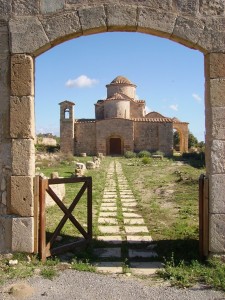
Panayia Kanakaria – Karpaz
Continue on to Yeni Erenkoy, once the centre of the tobacco industry, where evidence of this long defunct trade dominates the village centre. Here the tobacco warehouses are now converted into garage workshops and carpenters studios and down a long uneven track leading to the northern shore there are smoke houses that were used to impart special flavours to the tobacco. There is also a magnificent, albeit ruined, carob warehouse.
In the nearby village of Sipahi, the 6th C AD basilica floor of Ayias Trias has some of the most beautiful mosaics in North Cyprus and is well worth the short detour.
The road from Yenierenkoy is being widened and straightened to facilitate the access of traffic to the village of Dipkarpaz and the developments into tourism that are taking place in the area. Currently at the time of writing, mid March 2010, traffic is being diverted between Yenierenkoy and Dipkarpaz along the roads that run along the south coast. The route is picturesque but will take slightly longer.
Dipkarpaz is a mixed village of both Turkish Cypriot and Greek Cypriot inhabitants. Thus it has a mosque and an Orthodox church. It has a Greek coffee shop and a Turkish coffee shop. There are several emporia selling everything a household needs; pots and pans, paint, brushes, shampoo, vegetables etc. Typically as in most villages some of the stock is years old, covered in dust and priced in a currency from years ago when we had millions of Turkish Lira to the pound!
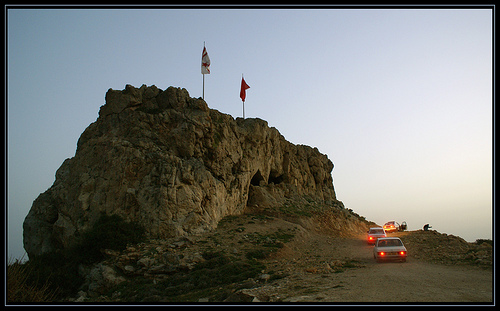
Zafer Burnu – Karpaz
The roads from Dipkarpaz lead to the north or the south coasts. To the north is the city site of Carpasia and below it on the shoreline is the basilica of Ayios Philon. The partially domed building built in the 12th C AD was constructed on the site of an earlier Byzantine church from the 4th C AD. The foundations and floor mosaics from this church are visible to the south of the main building.
The roman harbour makes a good swimming spot and sometimes during the mating and nesting season, turtles can be seen feeding in the azure waters. The Oasis cafe serves good food on a shady terrace and provides basic accommodation.
To the east of Ayios Philon, about six kilometres along a tarmac road is the collectively named site of Aphendrika with three ruined churches from the Byzantine era. On the approach, the first one is dedicated to Ayios Yeoryios, the next one is the largest and dedicated to the Panayia Chrysiotissa, the third set on a slight rise to the right is named for the Panayia Asomatos. All were destroyed by the Arab raids of the 7th C AD, though Panayia Chrysiotissa was rebuilt during the 16th C AD.
Continuing eastwards along a dirt track, still within the area called Aphendrika, is a major city site dating from the 2nd C BC, there are the remains of rock cut tombs to be found among the dense undergrowth and evidence of dwellings built partly into the rock. There are also the remnants of the ancient harbour.
Going south from Dipkarpaz, the road runs close to the southern shore all the way to the tip of the island. Along this route there is an abundance of agriculture and not a lot else apart from sandy beaches, donkeys, colourful birds sitting on the telephone wires and a scattering of local restaurants until you get to the Monastery of Apostolos Andreas. This church was never a monastic establishment in the true sense but it is one of the most important pilgrimage sites on the island. It was here that, according to legend, St. Andrew came ashore and struck the rock with his staff causing fresh water to gush forth. There is a small chapel, that is kept locked, built over the source of the spring but there are taps from which the healing waters can be poured. Both Muslim and Orthodox Cypriots have great faith in the curative powers of this water and bottles of it are transported back to many parts of Europe to aid sick relatives.
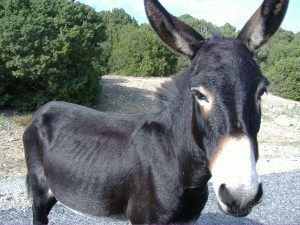
Karpaz donkey
This is the centre of the conservation area for the Karpaz donkeys and they will be seen wandering freely along the roads, tracks and among the juniper bushes. Please note they have the right of way.
Beyond the monastery the track continues and passes the Sea Bird Motel. This is basic accommodation in wooden huts and the converted British era Customs and Excise houses. The food is good and there is a beautiful sandy cove for swimming.
At the far end is Zafer Burnu/Cape Andreas, and this is as far to the east as you can get. Here the wind always blows and the colliding currents swirl dangerously as they mix among the small islands offshore. There is a police house where sometimes a policeman can be found, keeping a sleepy eye open on the lookout for illegal immigrants. For company he has the sea birds as they fly in the thermals above and the grazing donkeys. An enviable job indeed, in a serene and peaceful setting.
Accommodation in the area varies, from very basic cabins on stilts built close to the shore to hotels and holiday villages with all facilities. On a personal level I have got to an age when I don’t do basic anymore so my recommendations for staying somewhere central and exploring the peninsula at leisure are as follows:
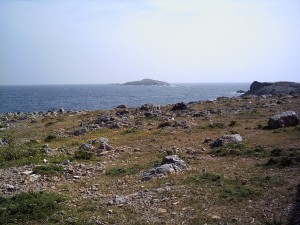
Zafer Adlari (Kleides Islands) from Cape Zafer
The Theresa Hotel east of Yeni Erenkoy, the accommodation is simple but what elevates this establishment into a higher bracket is the quality of the rustic country mezze with salad, superb deep fried fish and probably the best chips on the island! There is a small partly sandy beach with sunshades for swimming www.theresahotel.com telephone 0090392 3744266
Balci Plaza about two kilometres east of the Theresa Hotel provides bed and breakfast and is also excellent for families who want to self-cater. The apartments are very well equipped and sleep two or four people in twin bedded rooms. Some of the two bedroom apartments have cot beds supplied and there is also a sofa bed. There is a small sandy cove a few minutes walk away that has an honesty bar with a well stocked fridge and the main dining room is also a couple of minutes away from the main accommodation building. With only twelve apartments this is a very popular place in summer and booking is essential. www.balciplaza.com telephone 0090392 3745075
Villa Lembos in Dipkarpaz, follow the signs for Ayios Philon, is a collection of small detached and semi-detached bungalows. There is twin and double bedded accommodation, excellent shower rooms, refrigerator, and it is all finished to a very high standard. There is a good a la carte menu for lunch and dinner, serving Turkish food, and a substantial breakfast. The gardens are well laid out, extremely colourful and well cared for. www.villalembos.com telephone 0090542 8729415


